
Voigtländer was a famous German camera company which name still exists today, but as a Japanese-owned company which makes Leica-style rangefinder cameras. Voigtländer was founded in 1759 in Vienna before cameras really existed. It produced optical products such as lenses and later also some of the first ever cameras. It moved to Braunschweig, Germany in 1849, where it started producing box and plate cameras, developed new lenses such as the Heliar. In the 1930s it started introduced the Bessa 6x9 and Vito 35mm folding cameras.
After WWII Voigtländer continued to produce top-quality cameras and lenses, with famous models such as the Vitessa and Prominent cameras and Ultron and Nokton lenses, but eventually it ran into financial trouble and merged with Zeiss Ikon. It was later transferred to Rollei and survived in various reincarnations until 1994, when the last branch of Voigtländer in Braunschweig closed. However, the brand name still exists and is used by Japanese firm Cosina to market high-quality 35mm manual lenses and occasionally film cameras, and as such contributes to and encourages the recent revival of film photography.
Voigtländer Virtus
Voigtländer was a company that always sought to innovate and do things a little differently. A prime example of this was their line of folding cameras recognisable by their unique gear-style wind knobs, the Inos, Prominent, Virtus and Perkeo. The 1932 Prominent 6x9 was the most advanced of those, featuring a coupled rangefinder (a rare feature at the time, only just introduced on Leicas and the Contax I) and an extinction meter. The Virtus was a more modestly specified camera, but with the same exquisite build quality and it did have a viewfinder with automatic parallax correction, also rather unique at the time. In addition, it was unusual in having a viewfinder on the narrow end of the camera. As the camera was 3x4 format, this meant the film frame was in landscape format, in contrast with most vest pocket cameras from that era, which were in portrait format. Of course one could simply rotate either style of camera by 90 degrees to get the other format, but the Virtus was the only one I know of specifically designed this way.
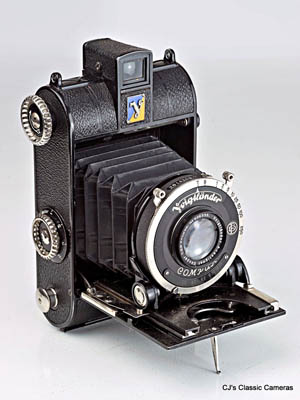
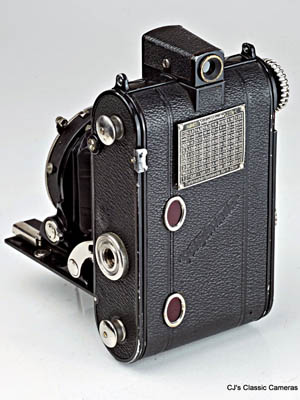
A 1933 Voigtländer Virtus with Anastigmat Skopar 75 mm f/3.5 lens in Compur shutter. It would originally have come with a braided leather strap, but these are rarely still there.
Voigtländer Bessa
The Voigtländer Bessa was a 6x9 medium format folding cameras and similar to cameras like the Welta Trio, Wirgin Presto, Balda Juwella and so many folders build between WWI and WWII. Not that there was anything wrong with that, the Bessa was a very capable camera and set itself apart by using Voigtländer's own lenses. It's main claim to fame though, is that it gave rise to the Bessa RF and later the Bessa II, one of the most iconic folding cameras in history (see below).
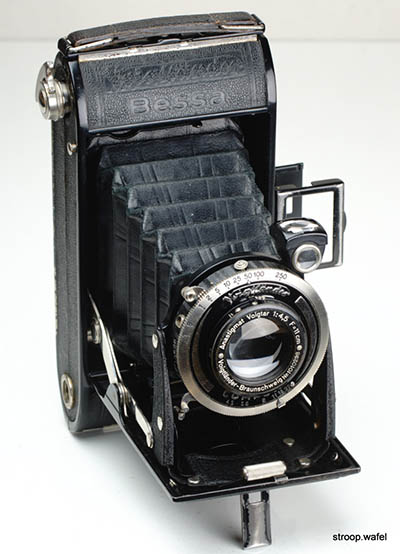
|
A Voigtländer Bessa with Voigtar Anastigmat 110mm f/4.5 lens in Compur shutter. I fixed this one for a client and was pleasantly surprised by the quality of the photos. Holding a 6x9 negative is something else if you're more used to 35mm!
|
Voigtländer Bessa II
The Voigtländer Bessa II was one of the few 6x9 medium format folding cameras with a coupled rangefinder, which goes some way to explaining its legendary reputation. In addition it was an extremely well-build camera with a range of great lenses, from the four-element Color-Skopar to the five-element Color-Heliar and exceedingly rare and expensive Apo-Lanthar. The camera would focus by rotating the focussing knob on the right side of the camera (whilst facing it), this would also move the coincident rangefinder image. The whole lens/shutter assembly would move while focussing, in contrast to helical focussing like, e.g., on the Balda Super Baldax.
On the downside, the viewfinder image was perhaps a little small and the wind mechanism was a simple 'turn the knob till the next number appears in the red window' type. The camera was also a little unusual in being what one could call left-handed, as the lens door opened to the left, unlike most other folding cameras including most other Voigtländers, and shutter release and focussing mechanisms were operated with the left hand. That said, the camera was easy to hold and operated very smoothly, including the door-mounted shutter release.
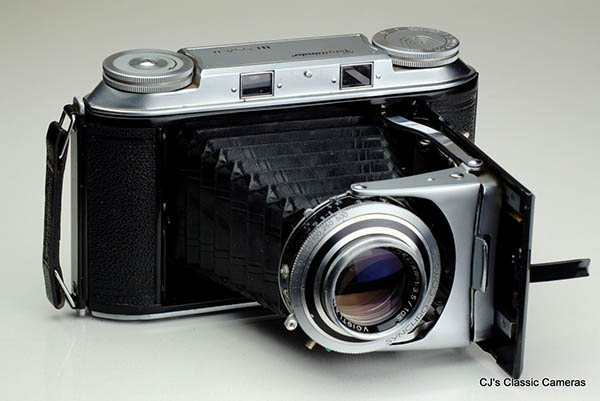
A Voigtländer Bessa II with Color-Heliar 105/3.5 lens in Synchro-Compur shutter from 1952. This is an early version without accessory shoe, although a separate shoe was available which could be fitted in-between the rangefinder windows.
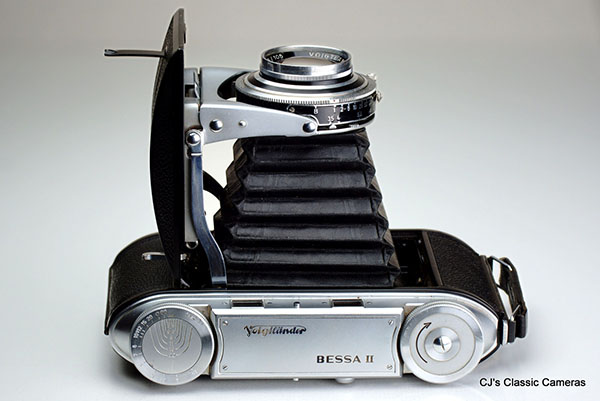
Top view of the Voigtländer Bessa II.
Voigtländer Vito I
The Voigtländer Vito I was the first of the 35mm Voigtländer folding cameras, introduced a shortly before the start of WWII. Somewhat curiously, the first version was designed to use unperforated film, apparently with the aim to get a larger 30x4mm frame size (like 3x4 127 film). However, this idea was never realised and later post-WWII production used regular 35mm film cassettes.
Like most Voigtländer cameras it had several complex and interesting design features. For example, when opening the front door, a small rail on top of the door would pop up, this was the film release. It would retract again when closing the front door. In addition, it would stay down after releasing the shutter, and only pop up when the film was would to the next frame, a clever design to avoid double exposures.
The Vito I was followed up by the Vito II, which had a slightly higher, straight top housing and different shutter release, and the Vito IIa, which can be found below.
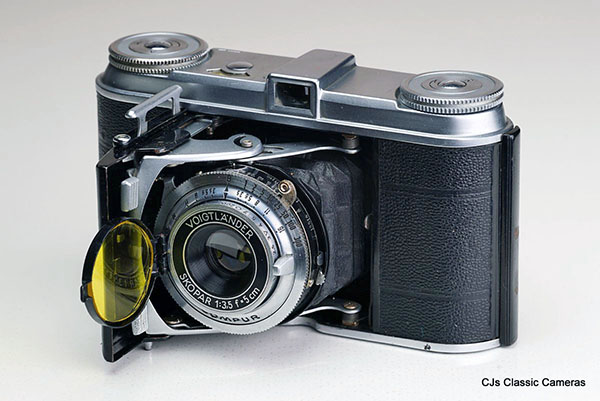
A Voigtländer Vito I with Color-Skopar 50mm f/3.5 lens in Compur shutter. A yellow filter was included with the camera and could be folded out of the way if not needed. According the lens serial# this example was build in 1942, not long before production was halted due to WWII.
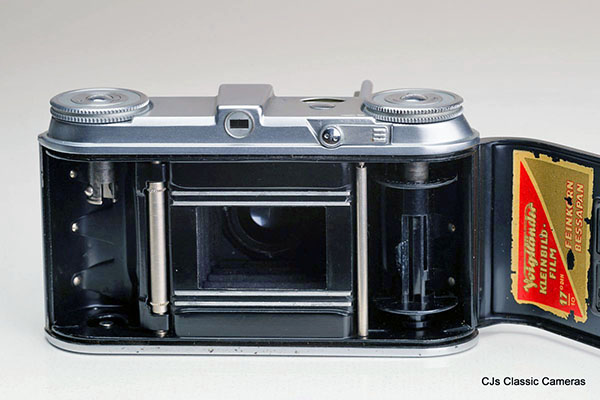
interior of the Voigtländer Vito I. Note that there is no sprocket wheel, instead there was a small sharp-toothed wheel that followed (and perforated!) the film and thus sensed how far it had moved. Also note how far the feeler wheels were apart, about 33 mm: just enough for use with regular 35mm film, as the wheels actually avoid the film perforations. However, on my example they slip as the teeth are not sharp enough.
Voigtländer Vito III
The Voigtländer Vito III was the top dog amongst the 35mm Voigtländer folding cameras. It featured a coupled rangefinder and a newly introduced fast six-element Ultron f/2 lens, all in a relatively small package. It was introduced in 1950, only slightly earlier than the Prominent I (see next) with which it shared many features, in fact the top and bottom of the cameras were nearly identical, and so were the focus and wind mechanisms. As the Vito III had a fixed lens, it was a lot lighter, and thanks to its folding mechanism, also a lot smaller. The folding mechanism itself was quite similar to that of the Bessa II, but was rotated by 90 degrees, as the Vito III front door open downwards, not sideways. It was in production for about 4-5 years, after which Voigtländer discontinued it in favour of their other 35mm folder, the Vitessa (see below).
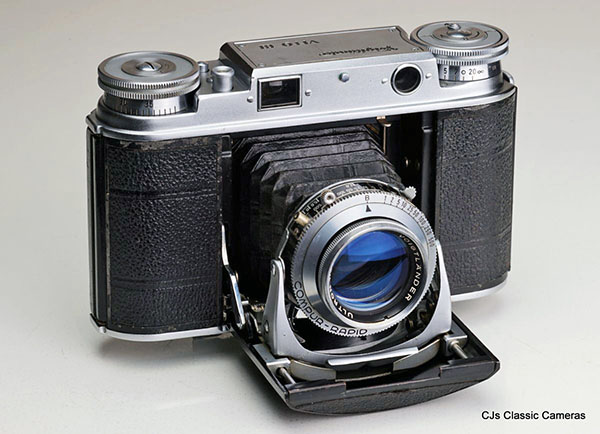
A Voigtländer Vito III with Ultron 50mm f/2 lens in Compur-Rapid shutter. Later production had Synchro-Compur shutters, but other than that changes during production were only small. Note the distance markings on the rewind knob, which doubled as a focus knob.
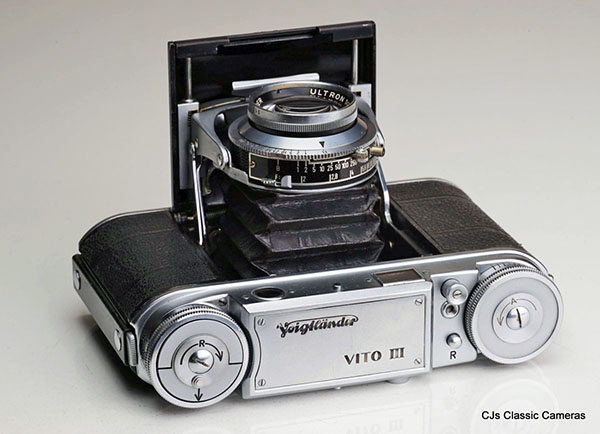
Top housing of a Voigtländer Vito III, which was identical to that of early Prominent production without accessory shoe.
Voigtländer Prominent & Prominent II
The Voigtländer Prominent was introduced in 1950, around the same time as the Bessa II. It was a very high quality rangefinder camera with interchangeable lenses, the first leaf shutter camera one could call a system camera. Presumably it was meant to compete with the Contax and Leicas. Unfortunately the lens mount was unique to the Prominent and none of the later Voigtländer cameras with interchangeable lenses used this particular mount. The focussing mechanism was peculiar although similar to the Bessa II; it had a focussing wheel at the top of the camera which would move the complete shutter and lens assembly forwards and backwards. That also meant that the interchangeable lenses were fix focus lenses, further prohibiting their use on other cameras.
Unfortunately the cameras ergonomics were rather awkward, it was very heavy and the viewfinder eye piece was set quite far to the right whereas the focus knob was on the left, all this made the camera a little awkward to hold and operate. Later similar system cameras such as the Agfa Ambi Silette and Kodak Retina IIIS where certainly more easy to operate, perhaps their designers learned from the comments on the Prominent.
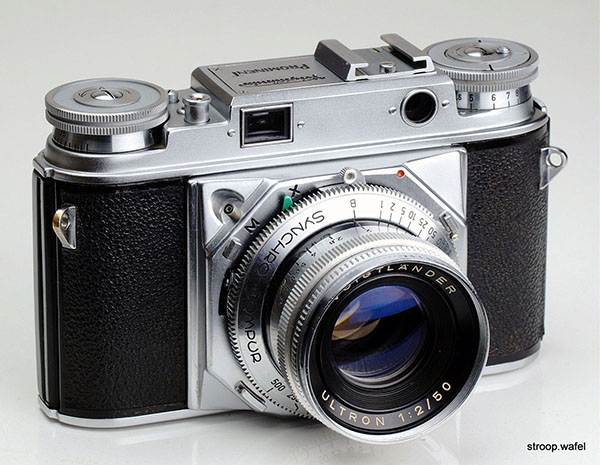
A Voigtländer Prominent with Ultron 50mm f/2 lens in Synchro-Compur shutter. This example is a later version with accessory shoe, which was introduced around 1954.
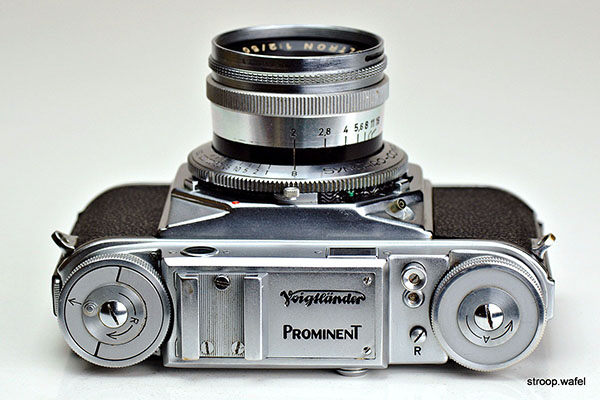
Top view of the Voigtländer Prominent. This camera was full of interesting design details, one of them being the rewind knob, as a small handle would pop up when the little button next to the small arrow was pushed. Note that this was also the focus knob.
Despite my critisism above, the Voigtländer Prominent was a superbly finished camera and all controls are smooth and flawless, other than the focussing system which has a rather strong spring which makes close focussing much harder than far focussing. The lenses also had an excellent reputation, including the legendary Nokton 50mm f/1.5. The Prominent I was built for about eight years, from 1950 until 1957, after which the Prominent II was introduced. Quite a few variants of the Prominent exist, as small changes were made throughout its production. The earliest version had a Compur-Rapid shutter and lacked an accessory shoe or strap lugs. Soon after the shutter was upgraded to a Synchro-Compur. Strap lugs were introduced around 1952, an accessory shoe around 1954. In 1956 a wind lever was added to the wind knob and finally in 1957 some improvements were made to the viewfinder.
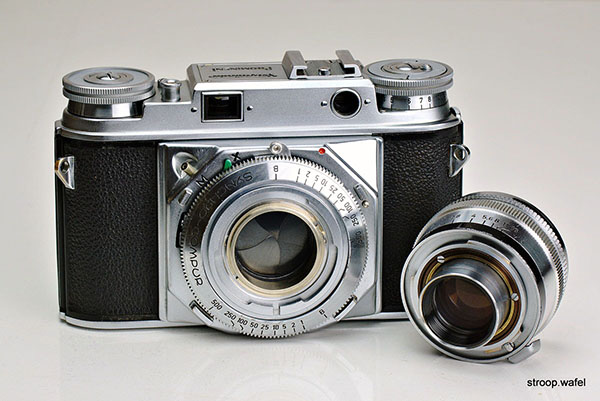
The Voigtländer Prominent with lens dismounted to show the lens mount itself. It was a bayonet style which mounted easily but was unfortunately unique to the Prominent system.
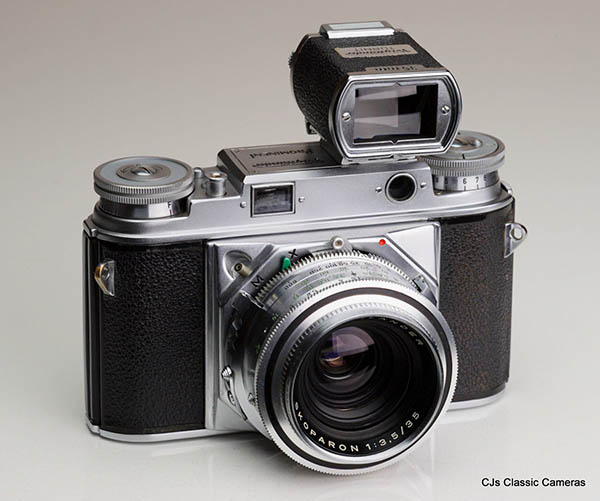
The Voigtländer Prominent with Skoparon 35mm f/3.5 lens. Instead of being mounted directly onto the shutter like the standard lens, the Skoparon had its own separate mount on the camera body, which it shared with the telelenses. It had a rather unique focus mechanism: the whole lens assembly was spring-supported and was pushed back and forth by the focus mechanism on the camera body.
The large viewfinder mounted on top of the camera is called a Turnit, which works for wide angle as well as telelenses simply by turning the whole unit around.
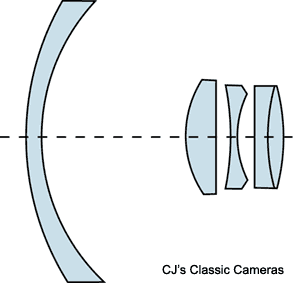 |
The Skoparon was a five-element lens with four groups, the rear group being a doublet, and essentially it was a Tessar design with a large diverging meniscus lens in front of it (see optical design on the left). This may seem counterintuitive, but the result was a wide-angle lens that could be positioned further from the film plane than its focal length, needed on the Prominent because of the interchangeable lens mount and the whole lens being in front of the leaf shutter. This design is known as a retrofocus design, first developed around 1950 by Angenieux in France. It is also called a reverse telelens design, as the opposite principle was used to make compact telelenses that could be closer to the film plane than their focal length. |
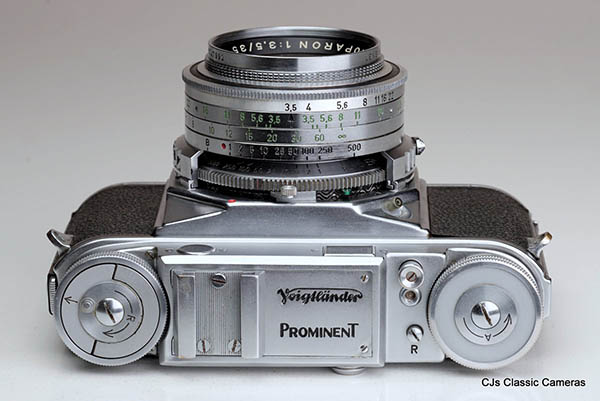
Top view of Skoparon 35mm f/3.5 lens. Note the lens had aperture control as well as a depth-of-focus scale disguised as a focus ring. It also had its own shutter speed markings, which matched up with a marker on the speed ring on the camera. It seems complicated but it doesn't take long to get used to and it works well.
An interesting detail of all Prominent lenses is the patterned grooved ring just behind the front ring of the lens (best visible in the photo above). This is actually a screw thread on which dedicated Prominent filters could be mounted and which was the same size for all Promintent lenses. I guess Voigtlander designed the filter thread this way for esthetic reasons, as a regular thread would not have looked as good, but it is such a good disguise that I didn't realise it was a filter thread until I received a lens with a filter on it!
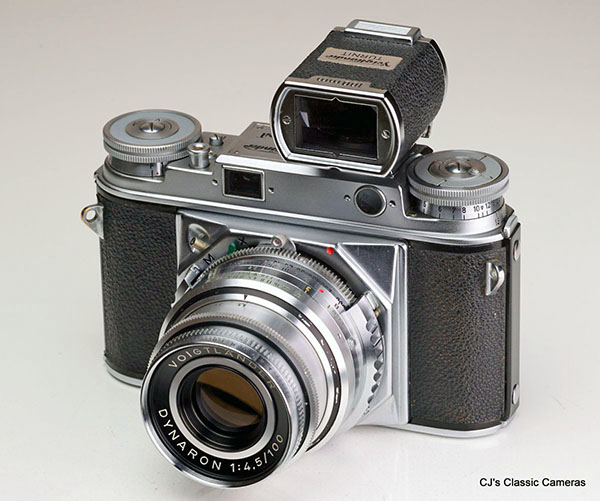
The main telelens of the Prominent system was the Dynaron 100mm f/4.5 lens. It was used in the same way as the Skoparon above.
The Prominent II was introduced in 1958 as an upgrade to the Prominent I. The main improvements were a new, large 1:1 brightframe view/rangefinder and the introduction of a double-stroke wind lever. Otherwise the camera was nearly identical to late examples of the original Prominent. The viewfinder was a great improvement, giving a view similar to that of the Leitz SBOOI viewfinder, although not as bright due to the semi-transparent mirror needed for the rangefinder, and also not quite up to the standard set by the Leica M3. It also showed frame lines for other (35 and 100mm ) focal lengths. To make room for this large viewfinder the top housing had to be enlarged, resulting in a somewhat less sleek-looking camera compared to the earlier Prominent, and sadly it still had the same flaws making it awkward to use. Total production is said to be only about 6400.
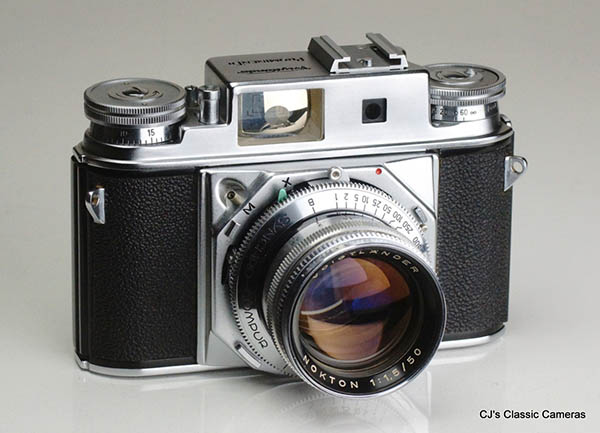
A Voigtländer Prominent II with 50m f/1.5 Nokton lens. The latter was a 7-element lens developed especially for the Prominent range, and widely regarded as one of the best lenses from that era. Unfortunately adapters to mount the Nokton on modern cameras are not readily available, due to the lack of a focussing mechanism in the Prominent lenses.
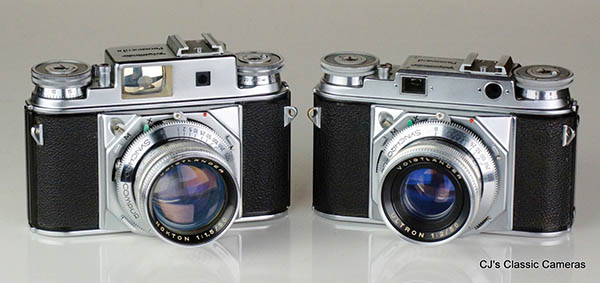
Voigtländer Prominent I and II side by side. It would be hard to pick a favourite, the I looks better but the viewfinder of the II was a big improvement.
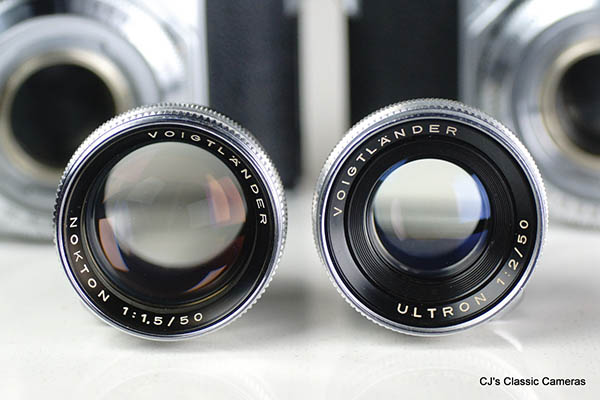
Two great lenses side by side. They shared the same lens barrel, but the lens elements of the Nokton stick out a little further at both ends. The difference between f/2 and f/1.5 apertures may not seem much, but the difference in light transmission can clearly be seen here.
Voigtländer Vitessa
If the Voigtländer Prominent represented the photographic equivalent of an executive-class Mercedes, then the Vitessa was certainly the Porsche in the family. It was sleek, extremely well-build and, as the name indicated, fast indeed. Its design was notably quirky, with a barn-door style folding mechanism and a large plunger to advance the film and cock the shutter. This was probably were the name Vitessa came from, as one could progress the film with one hand and fire with the other, which meant one could shoot 2-3 frames per second. That is, if one had a well-trained left index finger, as it takes some force to push the plunger down.
The Voigtländer Vitessa had a decent enough coupled coincidence rangefinder which was operated by the thumb wheel at the back of the camera. The whole lens base would move to and fro to achieve focus, like on the Bessa II. For those puzzled how to close the doors, one simply pushed on two markers on the shutter above and beneath the lens. To open them one had to push the shutter release button, on early models this would also release the plunger, on later models one had to release the plunger first.
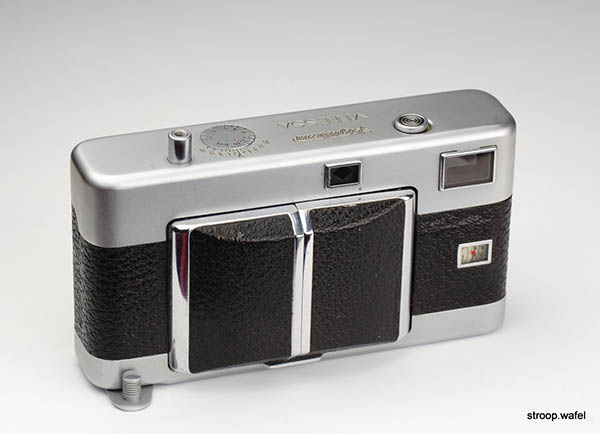
The first Voigtländer Vitessa, here with Ultron 50mm f/2 lens in Compur-Rapid shutter. The lens serial# suggest it was made in late 1950, although the camera itself was not introduced until 1951. This is in fact my oldest Voigtländer camera, it predates both the Bessa II and the Prominent above, even though it looks more modern.
The rewind lever doubled as a stand on this and other early models. Later models had a dedicated fold-out stand at the bottom of one of the front doors.
Move the mouse over the image to see the the doors open and the plunger up.
Several versions of the Voigtländer Vitessa were produced. Rather strangely, the very first model appears to have been introduced in the USA first. This version (Vitessa A, 1951) lacked an accessory shoe or lightmeter and had a Voigtländer logo on top of the camera. The next version (Vitessa N, 1953) did have an accessory shoe and the Voigtländer logo was on the front of the top housing. Finally, the Vitessa L (1954) had an uncoupled selenium lightmeter, which somewhat interfered with the depth of field scale. All versions were available with fast f/2 Ultron lens or slower f/3.5 or f/2.8 Color-Skopar lens. An interchangeable lens version, the Vitessa T, was also available (shown separately below).
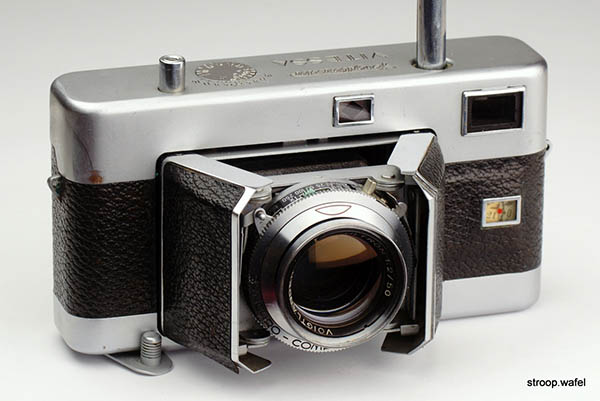
A later Voigtländer Vitessa A with Ultron 50mm f/2 lens in Synchro-Compur shutter from late 1952. Changes compared to the first version included automatic parallax correction, a completely removable back and a pressure release plate integrated in the back instead of hinged to the body, features which would persist in later models.
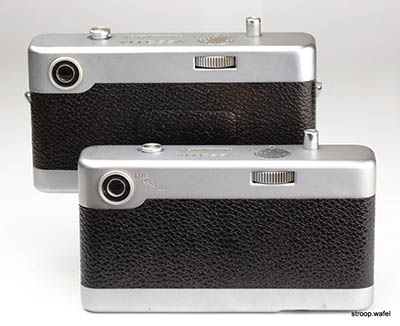
|
Both Voigtländer Vitessa A models shown from behing, with the earlier version in front. Note the parallax indicator marks on the earlier version and the bump in the middle of the back marked 'Germany' on the later version.
|
Several variants of each version existed, although the differences were generally subtle. The main difference was that later production (ca. 1956) of both the Vitessa N and L had a slightly higher top housing (careful observers may notice that the gap between the doors and the rangefinder window is a little larger on the Vitessa N below compared to the Vitessa L above) and a frame counter with an alternating black and white pattern instead of plain white. When pushed down in its rest position, the plunger of later production models sat about 5mm higher than that of early production.
A Voigtländer Vitessa L with Ultron 50mm f/2 lens in Synchro-Compur shutter. This is an early production example from early 1955.
The plunger mechanism of the Vitessa was a real marvel. Pushing it down would release the tension on the pressure plate to avoid scratching of the film during transport, push down a clutch to engage the film transport mechanism, it would then wind the film by a rotating spindle inside the plunger, and finally it would cock the shutter. A spring would push the plunger back up, ready for the next shot.
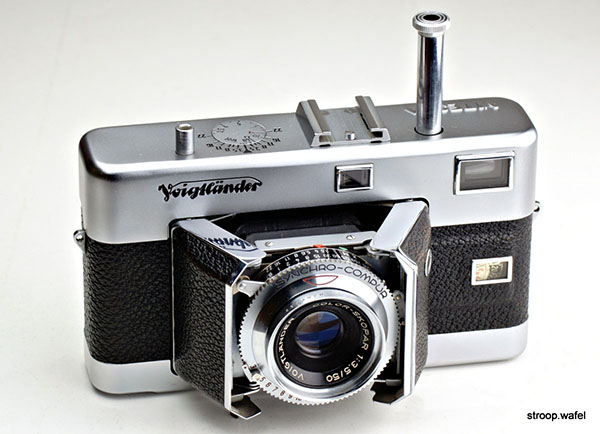
A Voigtländer Vitessa N with Color-Skopar 50mm f/3.5 lens in Synchro-Compur shutter. This is a late production example from mid 1957.
Interested in Vitessa's? Here is a great site with all the details. At the bottom of each page is a link to excellently documented photos of all the variants. In German but pretty self-explanatory.
Voigtländer Vitessa T
A Vitessa version with interchangeable lens mount, the Vitessa T, was also introduced, but this was no longer a folding camera - it had a big protruding lens mount instead. This mount was of the Compur Deckel kind, the same as the one on the Braun Colorette. The mount was similar, but not identical, to the Kodak Retina IIIS and most Reflex versions: on the Vitessa/Colorette mount the aperture ring was attached to the lens, not the camera body, whereas on the Kodak Retina and similar mounts, the aperture was set on the shutter on the body, which setting was than automatically transferred to the lens by means of a lever.
The Vitessa T was based on the Vitessa L, i.e., it was equipped with a lightmeter. However, the lens focus and rangefinder were no longer operated by a wheel at the back of the camera but by the focus ring on the lens instead. The range of lenses was somewhat limited, with the 35mm f/3.4 Skoparet, the 100m f/4.8 Dynaret and 135mm f/4 Super-Dynaret being the Voigtländer choices. The lack of an Ultron version is notable, especially since for the Prominent even a f/1.5 Nokton was available. Although due to the interchangeability with the Braun Colorette more lens options were available, in reality this did not add much to the range, and also here a fast prime lens was lacking.
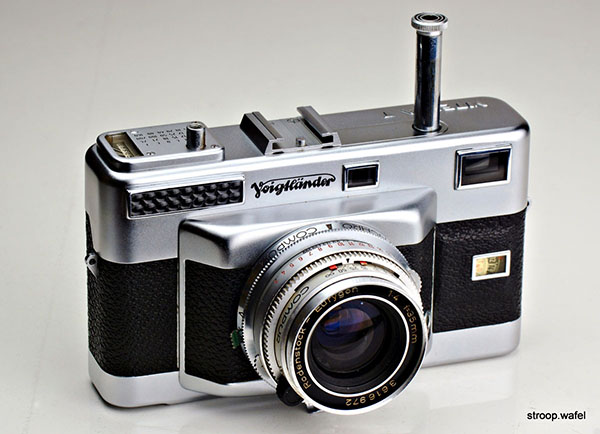
Since there are plenty of photos of Voigtländer Vitessa T with their standard Color-Skopar lens on the internet, I thought I'd mount a Rodenstock Eurygon 35mm f/4 originally from a Braun Colorette instead. Yes, it fits, and it works fine.
Vito IIa
The Vito 35mm folding cameras were introduced in 1939. The 1955 Vito IIa was the first to adopt the new top-house styling of the Vito fixed lens cameras, including a wind lever and pop-up rewind button. Thus it was essentially a folding version of the Vito B (see next). The lens was a Color-Skopar in either Prontor-SVS or Synchro-Compur shutter. The 'last' in the series of folding cameras was the Vito III - 'last' as it was in fact introduced before the IIa. It still had the old styling but included a coupled rangefinder and an Ultron f/2 lens.
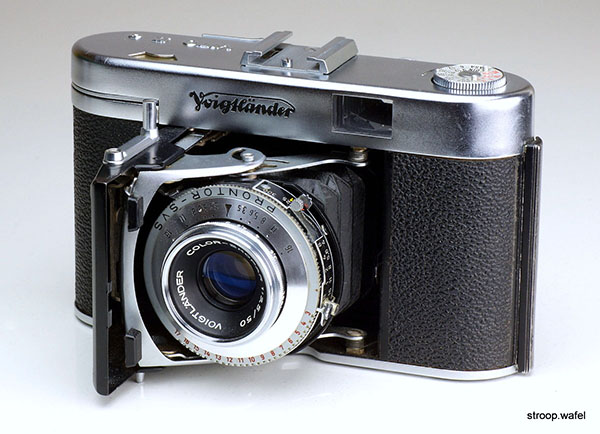
The Vito IIa, an attractively styled 35mm folding camera.
Vito B
The 1954 Vito B was Voigtländer's first fixed lens compact 35mm camera. It featured a lever wind, on-body shutter release and a pop-up rewind button. Part of the bottom plate opened to remove film or to be able to release the camera back to load film. Although the camera appears to have front-cell focus, the whole lens in fact moves backwards or forwards during focussing.
Two slightly different versions with different lens-shutter assemblies exist, as well as a version with a f/2.8 lens. A later version of the Vito B was introduced in 1957 and received a large bright frame viewfinder and an enlarged top housing.
Like most Vito cameras, the shutter will only release with film loaded, so cameras that appear to have a stuck shutter are usually fine. One can also push the film sprocket by hand to make sure. The shutter better be good as they are hard to work on, the whole lens needs to be removed to clean the speedcam.
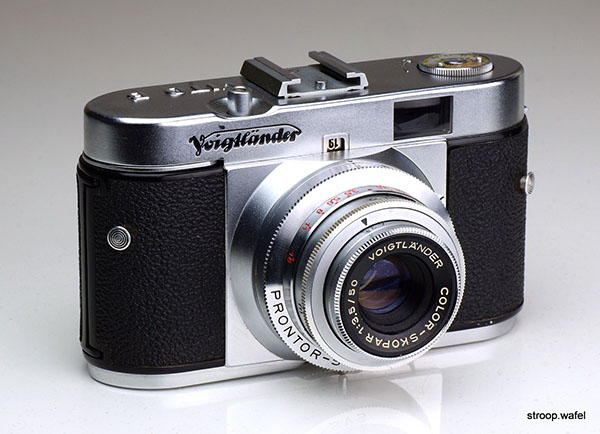
Early version of the Vito B with Color-Skopar 50mm f/3.5 lens in Prontor-SVS shutter.
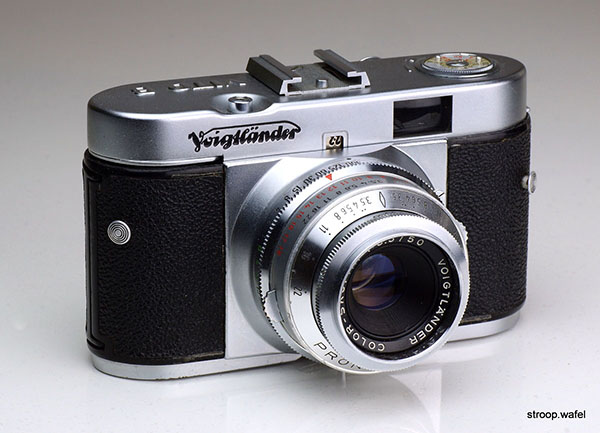
Late version of the Vito B with same specifications but having a different shutter housing and LV-type exposure setting ring.
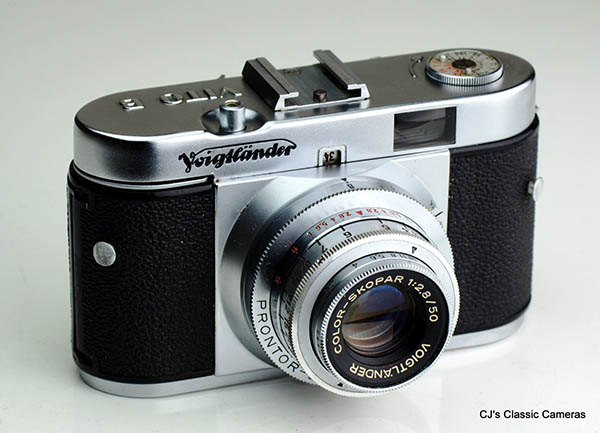
Version of the early Vito B with faster f/2.8 lens. These are quite rare and I was a little surprised to learn that it was the early version that had this faster lens, I incorrectly assumed it would have been the later version, which directly preceded the next version of the Vito B with large viewfinder.
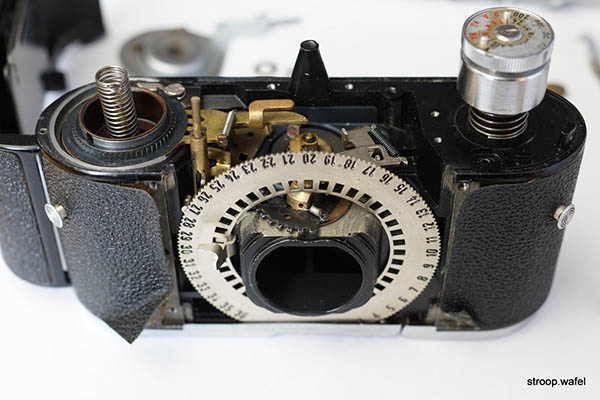
Vito B with top housing and lens-shutter assembly removed. The shutter was not cocking properly, hence the complete disassembly. Note the prominent frame counter ring, an engineering nightmare!
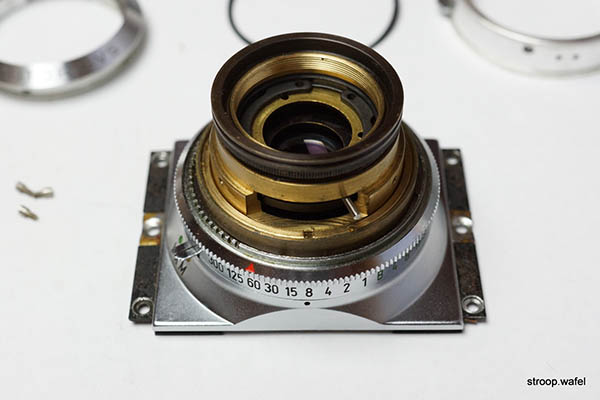
The lens-shutter assembly from the Vito B above with some lens parts and shutter rings removed. The whole lens was mounted in front of the shutter and moved as one unit during focussing. Virtually impossible to get to the shutter if it needs servicing.
Vito BL
The Vito BL was the lightmeter version of the Vito B. There were several different versions, all of which had a larger viewfinder compared to the original Vito B shown above, and included two different lightmeter models. One lightmeter was similar to the one on the Vitessa L shown earlier on this page, the other was a Bewi lightmeter that would show the correct exposure settings after pushing a button at the back (as on my example below).
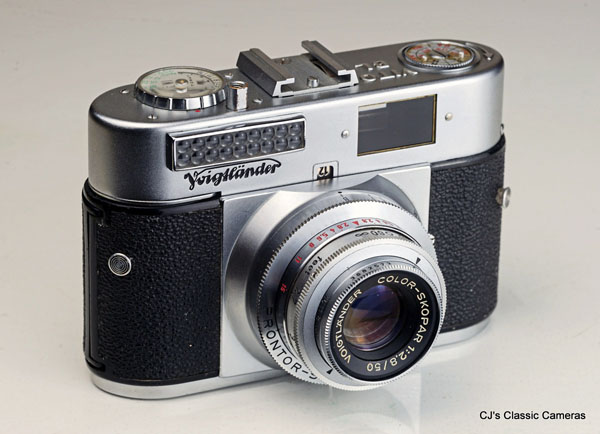
A Vito BL with 50mm f/2.8 Color-Skopar lens. This is an earlier version with a regular prism viefinder, whereas later production had a larger, reflective viewfinder (see Vito BR below for an example of this).
Vito BR
The 1958 Vito BR was the coupled rangefinder version of the Vito B with large viewfinder. This camera is not too common, I was lucky as one showed up in a large lot and was in good condition. The rangefinder base is rather narrow.
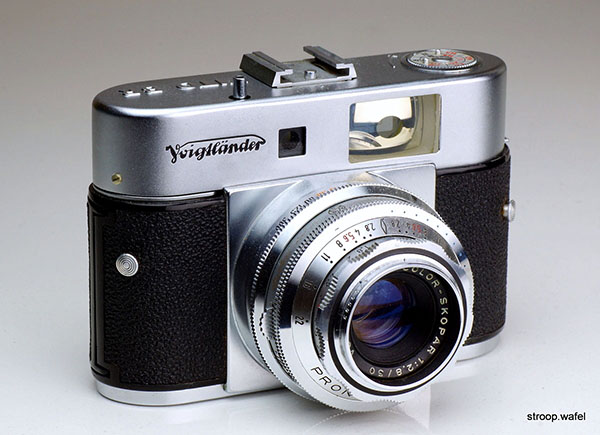
A Vito BR with 50mm f/2.8 Color-Skopar lens.
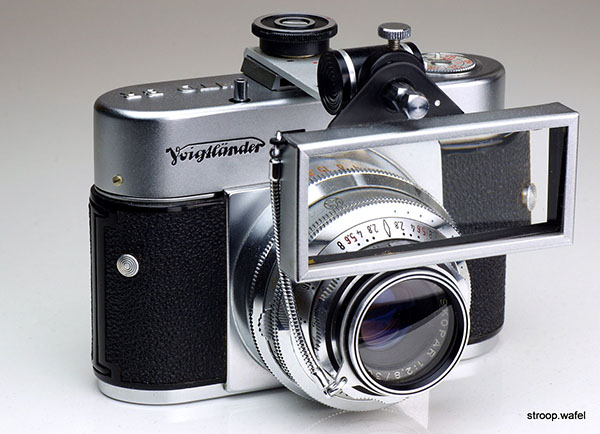
A Vito BR with proximeter, which is used for making close-up shots. The large screen adjusts the rangefinder view so that it matches the focus of the dioptre lens attached to the lens, so one does not need measure the distance to the subject and use tables to set the proper lens focus distance.
Vitomatic IIa
The Vitomatic series was introduced in 1958. They were developed from the later Vito B and included various coupled or uncoupled light meters. The I series were viewfinders, the II series rangefinders. The Vitomatic IIa had a coupled lightmeter with the needle projected in the viewfinder. It had a f/2.8 Color Skopar but can also be found with the Ultron f/2. The later (>1964) Vitomatic b and CS models had a restyled tophousing and shutter release on front of the body, like so many cameras from that time.
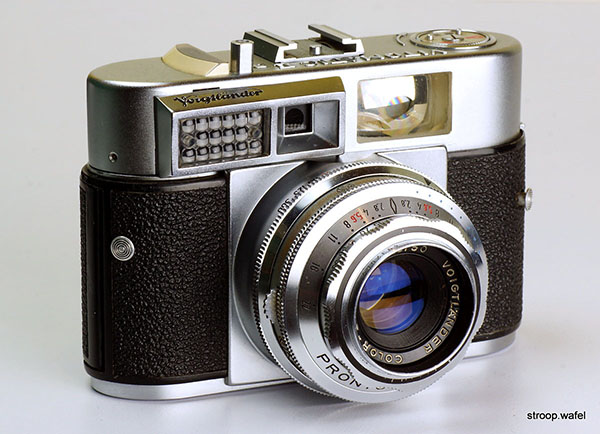
A Vitomatic IIa with Color-Skopar 50/2.8 lens.
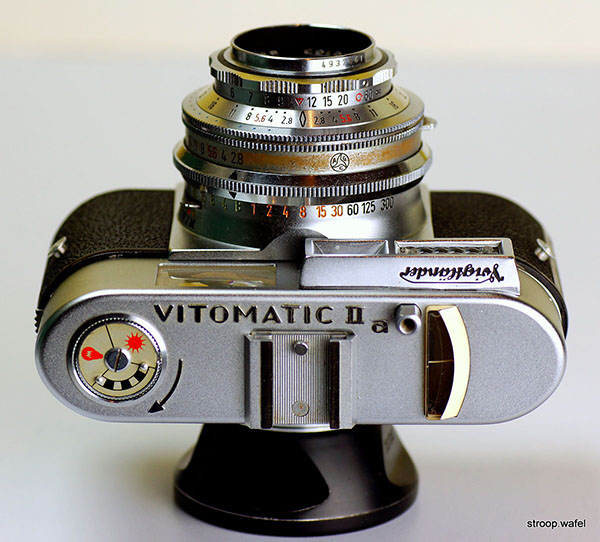
One of the fun things about Voigtländer cameras were the film indicators integrated in the rewind knobs. The one on the Vitomatic here is my favourite, the pictograms mean artificial light, day light or black and white film. Film speed would be set on the shutter so was not marked separately on the knob, like on models without light meter.
Vitomatic IIIb
The Vitomatic IIIb was probably the best fixed-lens rangefinder made by Voigtlander. It was perhaps not as striking as the Vitessa and Vito III were, but it exceeded these in terms of functionality by having a coupled exposure meter in a compact body whilst also sporting the famous Ultron f/2 lens. The exposure meter and aperture/shutter speed settings were visible in the viewfinder. It was also a rather handsome camera which had received a makeover compared to the earlier Vitomatic 'a' range, which looked a little utilitarian.
The Vitomatic 'b' range comprised the IIIb shown here as well as the Ib, which was a viewfinder only version with Skoparf/2.8 lens, and the IIb, which was identical to the IIIb but also had the slower Skopar lens. They were followed up by the CS range, which were pretty much identical but had a more reliable CdS meter, which did however need a battery to function.
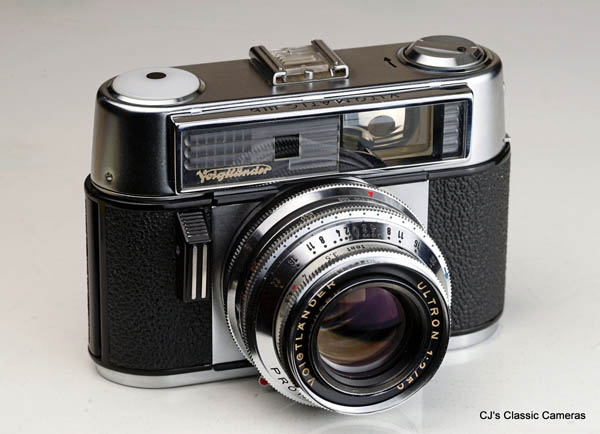
Vitomatic IIIb with Ultron 50/2 lens in Prontor 500 SLK-V shutter.
Vito CL
The Vito C series was introduced in 1960 as a cheaper alternative to the Vitomatic series. They had a restyled top housing and viewfinder, and a shutter release on the front. The lens was usually a Lanthar, a 3-element lens as opposed to the 4-element Skopar of more expensive models. The basic model had a viewfinder only, other models an uncoupled (Vito CD) or coupled (CL) light meter, the CLR also included a rangefinder. The CS and CSR were versions with battery-powered CdS light meters.
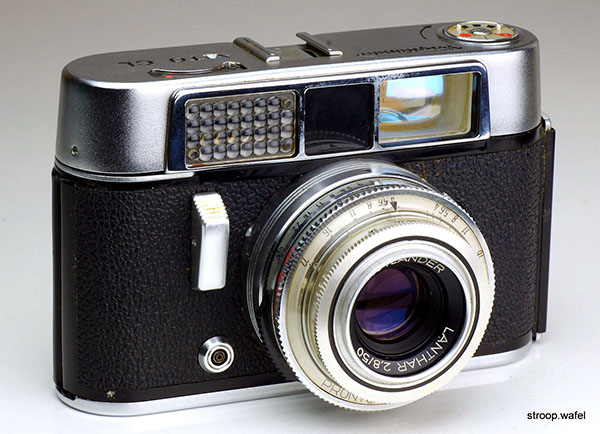
A Vito CL with coupled light meter. It did not quite have the same quality look and feel of the higher-end models.
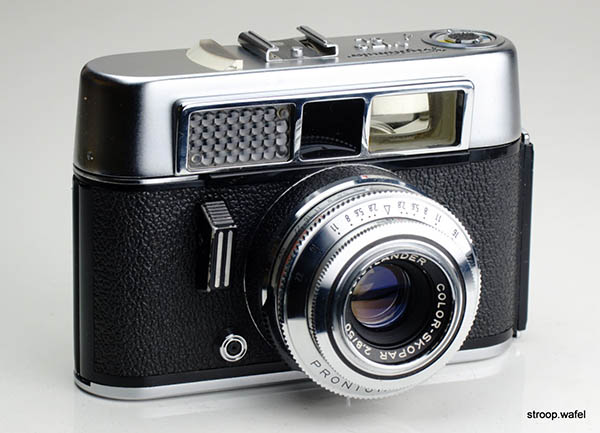
A later version (ca. 1963) of the Vito CL. Differences included the lightmeter window, name markings, film reminder dial and shutter button. This example also has a better lens, a four-element Color-Skopar instead of a three-element Lanthar.
Dynamatic
The 1959 Dynamatic was somewhat similar to the Vito C series but featured automatic exposure. The light meter was integrated in the lens front so the automated exposure would still be correct with filters attached. A luxury version had a chrome front plate and leather covering in-between the light meter cells, the Dynamatic II had the option to switch off the automated exposure.
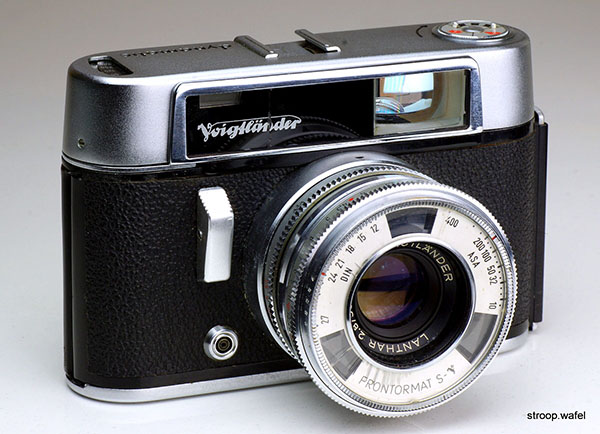
The standard version of the Dynamatic with f/2.8 Lanthar lens.
Vitrona
The Voigtlander Vitrona was a camera with a build-in electronic flash unit and came with a handgrip with battery pack that needed to be attached to the bottom of the camera. Although quite a few brands had flash versions in their camera line-up, such as the Leidolf Lordox Blitz, the Balda Baldessa-F and the Kodak Retina IIF, the Vitrona differed by having an electronic flash build-in, so it did not require a bulb that needed changing after every flash exposure. This made the camera a whole lot quicker and easier to use, plus you wouldn't burn your fingers changing a hot bulb. The presence of the large flash unit meant there was no rangefinder, but this was probably not a great loss for a camera designed for flash photography. The camera had an automatic flash exposure system, where the aperture was set automatically based on the selected shutter speed and focus distance.
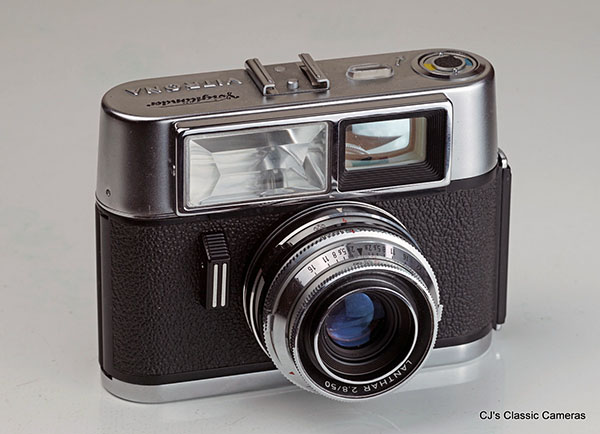
Voigtlander Vitrona with Lanthar 50mm f/2.8 lens in Prontor 250-V shutter. The indicator light on top of the camera would light up if the flash was charged and ready for use. Note the camera still had an accessory shoe, this was meant for a external rangefinder or lightmeter.
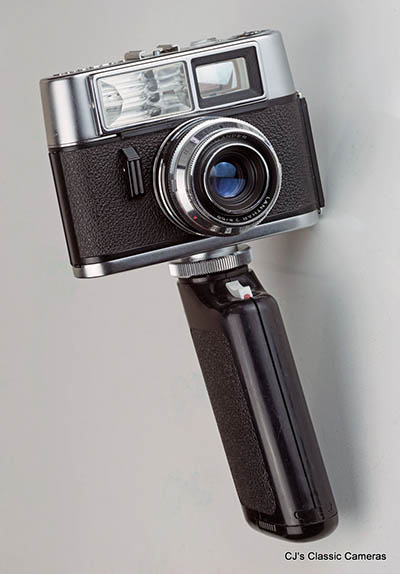
| | |
Voigtlander Vitrona with its battery grip attached.
|
Bessamatic Deluxe
The Bessamatic range was Voigtlander attempt to get into the SLR market, which was slowly taking over from the rangefinders. Voigtlander was a few years later than other brands such as Kodak (Retina Reflex) and Zeiss Ikon (Contaflex), but at least that gave them the opportunity to sort out the idiosyncrasies of these earlier models. The Bessamatic was a leaf shutter SLR with interchangeable lens mount, which meant a complex shutter and mirror mechanism (see here for some of the issues involved). Compared to some of their earlier quirky models such as the Vitessa and the Prominent, the Bessamatic was relatively straightforward to use with all controls where one would expect.
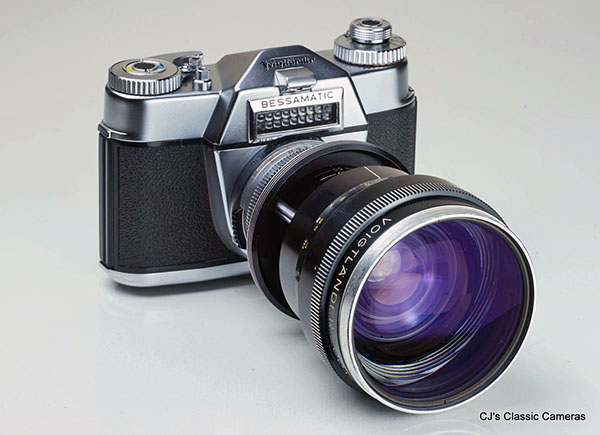
The Deluxe version of the Bessamatic with Zoomar 36-82mm f/2.8 zoom lens. This model showed the aperture and shutter speed settings in the viewfinder window using a small mirror mounted above the lightmeter. What looks like a filter on the lens is in fact the nearly flat front element (see below for more details about the lens).
The Bessamatic used the Compur Deckel mount also found on the Retina Reflex and Braun Paxette Reflex (but lenses could not be interchanged), but was incompatible with Voigtlander's own Vitessa T rangefinder. A wide range of lenses was available with focal lengths from 35 mm all the way up till 350 mm, but the crown jewel was undoubtedly the first commercially available zoom lens for 35mm cameras: the 36-82 mm f/2.8 Zoomar, introduced in 1959. This lens was developed in collaboration with Zoomar Inc. of New York, which produced this type of zoom lens for TV and movie cameras, and was built by Kilfitt of Munchen, well known for its Kilar lenses.
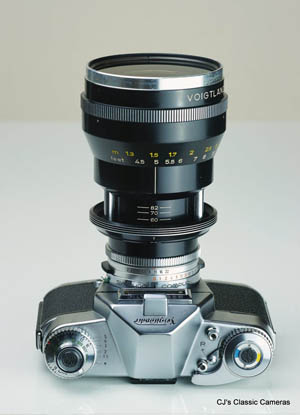
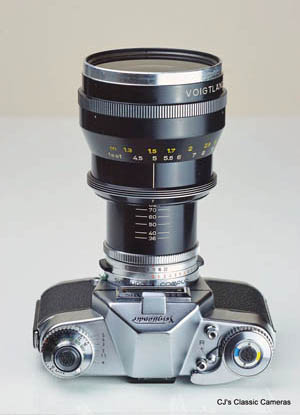
The Voigtlander Zoomar 36-82mm f/2.8 lens zoomed fully out (right) and in (left). Yes, it was a bit top-heavy.
One would maybe expect the first zoom lens to have a slow aperture and limited zoom range, but thanks to its 14 elements in five groups, it was quite the opposite: lenses of similar specs are still considered top of the range today, although nowadays they are commonly a little wider but shorter. The zoom control was through a large ring which one needed to push back and forth. The major drawback was the close focus limit, which was only about 1.3 m, i.e., much further than prime lenses, especially at the wide range. However, close-up lenses were available. It was also impressively heavy, the total package (including camera) in excess of 2 kg!
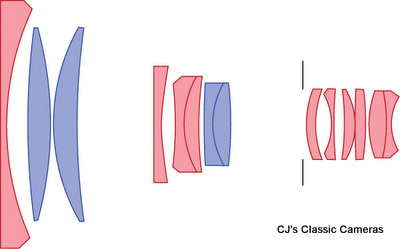 |
The Zoomar 36-82mm f/2.8 optical design. The pink lens elements are fixed in position, whereas the purple ones move as one unit, changing the lens focal length from 82 mm to 36 mm when moving from left to right. Focussing is done by moving the large front element alone.
|
Ultramatic CS
The Ultramatic CS was the last of the Voigtlander leaf shutter SLRs. In terms of ergonomics it had similar improvements compared to the earlier Bessamatic as the later Voigtlander rangefinders, such as a shutter release button on the front of the camera, reducing camera shake, a more conveniently positioned wind lever, and a pop-up rewind knob, giving the camera a much more streamlined look. There was also an earlier non-CS version of the Ultramatic which had a large selenium lightmeter cell in front of the viewfinder prism. The Ultramatic CS had a CdS cell instead and a battery compartment at the back of the top housing.
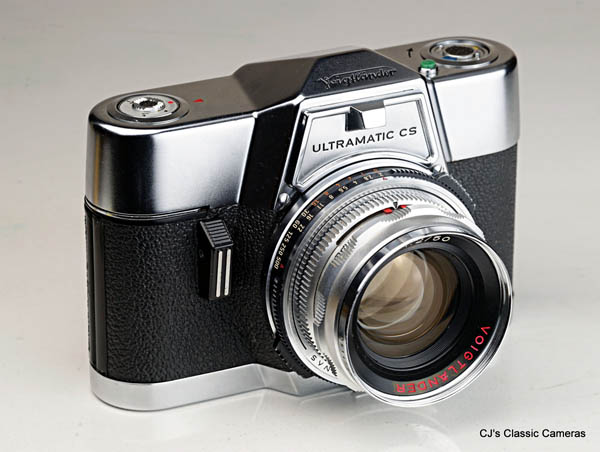
A Voigtlander Ultramatic CS with 50mm f/2 Septon lens. As the name indicated, the latter was a seven-element lens and had a great reputation, similar to the Ultron and Nokton available for rangefinder models. The Septon optical design was somewhere in-between the two; it was a little slower than the Nokton probably because the shutter diameter was smaller, a drawback of the leaf shutter SLR design. The mount was the Deckel mount one could also find on the Kodak Retina SLRs and on several rangefinders such as the Balda Baldamatic III, Kodak IIIS and Iloca Electric. The fact that this mount fitted SLRs as well as rangefinders is interesting in itself, as generally SLRs needed different mount and lens designs due to the larger distance to the film frame to make room for the mirror.
Leaf shutter SLRs have a pretty bad reputation as they were generally heavy and cumbersome, as well as prone to faults. I must say, the Ultramatic appears to defy that generalisation. Yes it's fairly heavy but not more than you'd expect for any Voigtlander camera, which were built to last, and it isn't exceptionally large either.
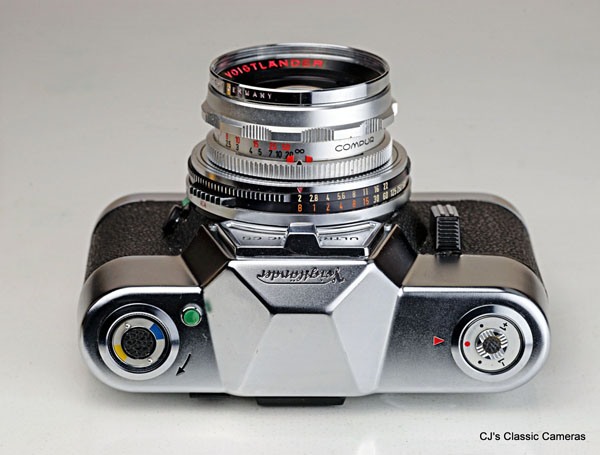
Top view of the Ultramatic CS showing its very clean top plate. The small green button is the battery test button, the dial on the right is to adjust the automatic exposure.
The name Ultramatic hinted at the functionality of the camera, as it had an auto exposure mode, although it could also be operated in fully manual exposure mode. Typical for Voigtlander SLRs, the exposure settings could be viewed via a small mirror in the viewfinder. The exposure system was a so-called TTL (through the lens) system; two light-sensitive cells were positioned on each side of the viewfinder eye piece. This automatically adjusts the exposure when filters are used, although the camera manual still recommended to set an exposure adjustment of +1 when using yellow, green or orange filters, presumably since the lightmeter cells had a different light frequency response than film.
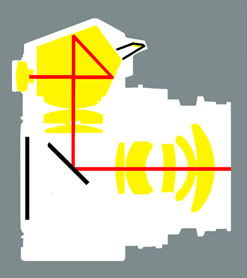
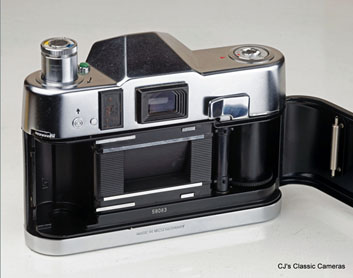
(left) Optical layout of the Ultramatic CS with Septon f/2 lens. The red line indicates the light path, which is also used for light metering. (right) Rear view of the Ultramatic CS. The black rectangle is the battery cover, which is missing its centre inlay. Note the light baffle in the film frame which blocked light from reached the film until the shutter was fired.
Bessa-L
As stated in the introduction of this page, the Voigtlander story didn't end well and the company was taken over by Zeiss Ikon and then sold on again, until eventually only the brand name survived. This name is currently (2020) licensed by Cosina in Japan, who from 1999 onwards produced a series of Leica-inspired rangefinders and even a reincarnation of the legendary medium-format Bessa II, but unfortunately production of all these ended some ten years ago. Instead, the company started to focus on high-quality manual lenses, using familiar names such as Heliar, Skopar, Lanthar and Nokton, and have managed to produce an impressive range of excellent glass.
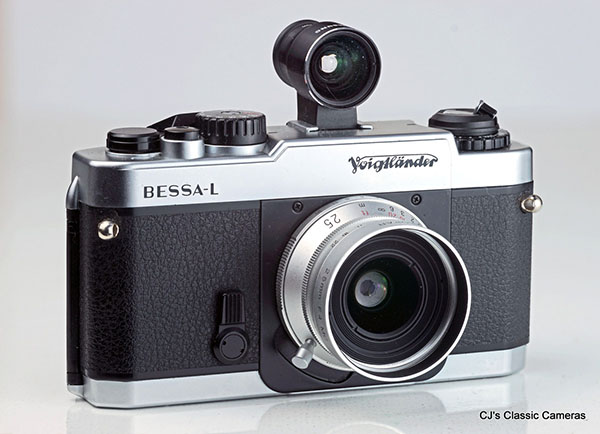
A 'new Voigtlander' Bessa-L with 25mm f/4 Color-Skopar lens. Like the Leica If and MD this was a 35mm camera without view or rangefinder, meant to be used with an accessory viewfinder matched to the lens mounted. This particular model is especially suited to wide-angle lenses, for which focus accuracy is less important (due to the large depth of field) and therefore the lack of a rangefinder is not an issue. Indeed, Voigtlander introduced extremely wide-angle 12mm, 15mm and 21mm lenses, each with their own viewfinder at the same time as the Bessa-L.
It probably looks a bit bigger on the photo than it really is, it's not much larger than original screw-thread Leicas and very light, especially with the tiny Skopar lens. Great for street photography. It handles very smoothly and easily, you do notice this camera is only about 15 years old, and not 60 or more like most cameras I normally use!
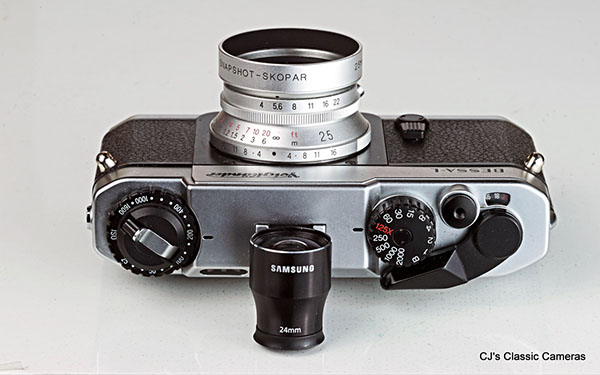
Top view of my Bessa-L with a 24 mm Samsung viewfinder mounted, which was originally designed as an optical viewfinder for Samsung digital cameras that are no longer in production, but works just fine with the 25mm Skopar and is a bit smaller than Voigtlander's version.
The camera controls are simple and similarly layout as Leica rangefinders. In addition, it has through-the-lens metering, which is very useful, but not that user friendly as it's not visible in the viewfinder, so one needs to keep an eye on the indicator lights next to the rewind knob whilst changing shutter speed or aperture to get the right setting.
| 
